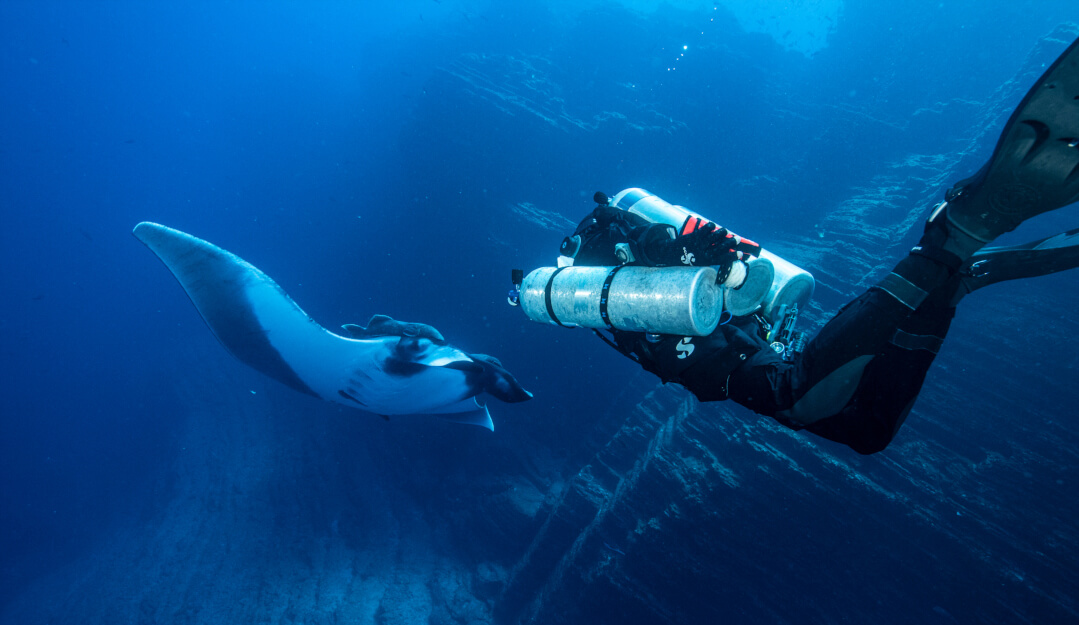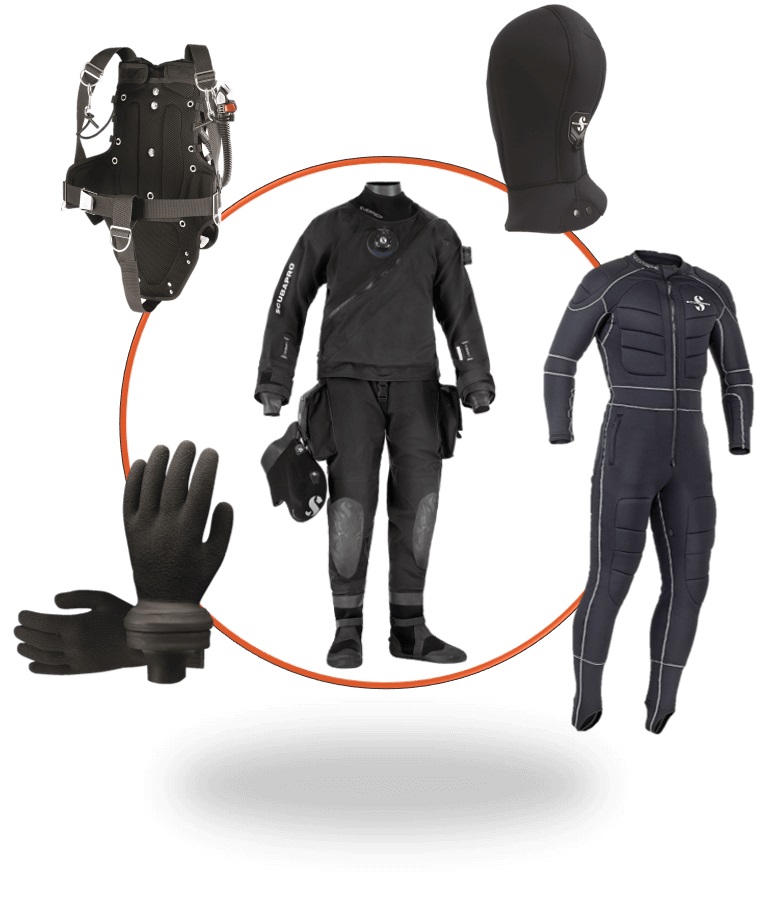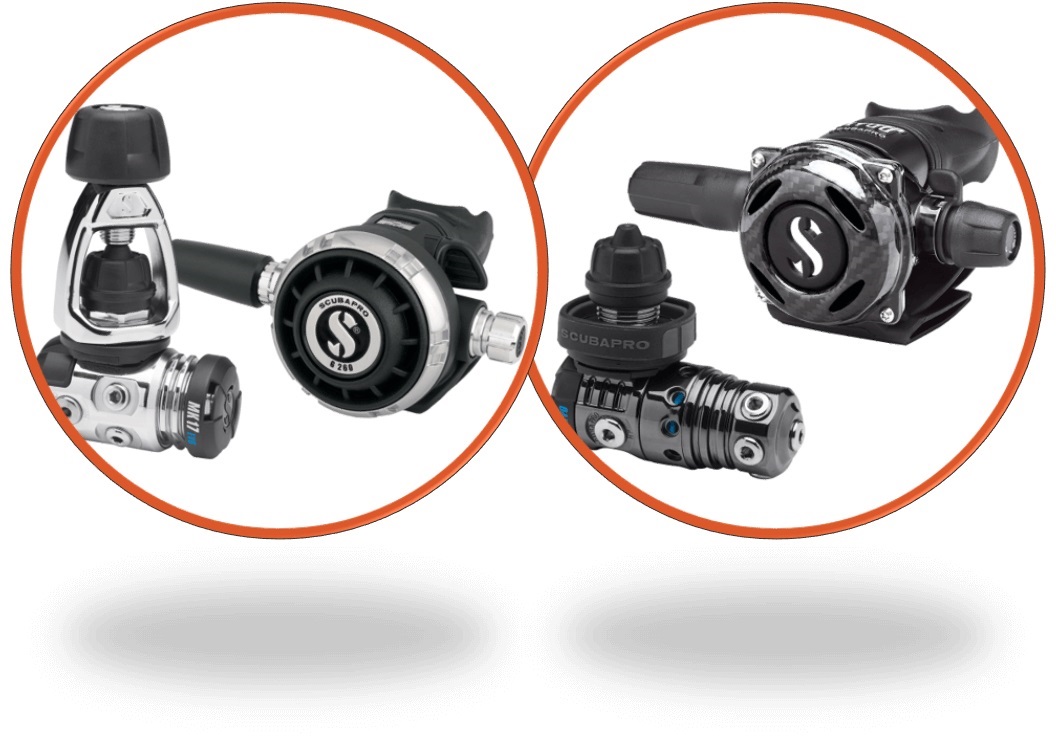The Technical Bits of Technical Diving
Many avid recreational divers, after logging hundreds of dives, after exploring myriad dive sites, after experiencing virtually all the joys of recreational diving, sometimes get to a point where they say, "That was really fun, but there must be more."
Rest assured, there is. Beyond the limits of recreational diving there are caves to be explored, wrecks to investigate, deep water walls teeming with unique marine life to encounter, frigid ice diving to experience. But in order to enjoy these out-on-the-edge dive adventures, you need a lot of special training and a dive bag of special equipment, because you've entered the world of technical diving.

What is technical diving?
Technical diving, also referred to as tech (or tec) diving, has many faces, so its definition tends to vary depending on who you ask. But most agree on a couple of key points:
- Tech diving involves venturing beyond the depth limits of recreational scuba diving of 130ft, with some tech divers commonly descend to depths in excess of 200 to 300 feet.
- Tech diving involves operating in an overhead environment. This means that you have to deal with a "ceiling" that you don't normally have in recreational diving that restricts direct access to the surface. This ceiling can either be an actual physical structure, like when you're inside a cave or a wreck, or it can be a physiological ceiling, meaning that a series of mandatory decompression stops are required before you're able to return to the surface.
Add to this the use of variable gas mixtures to ward off nitrogen narcosis or to accelerate decompression, and the need for advanced training and specialized equipment (including rebreathers), and you've got the earmarks of technical diving.
What type of equipment is used on a technical dive?
Technical diving requirements differ from those of recreational divers in a few key areas. Special BCD's called backplate/wings or sidemount are particularly suited to the needs of tech divers. Also, advanced regulators, dive computers, tanks and other gear will likely be needed. For a full list of the kinds of gear used in technical diving, check out our technical dive gear page.
Tech dive opportunities.
Advanced wreck diving
There are many shipwrecks scattered on the ocean bottom at depths shallower than 130 feet, so as a recreational diver you might have already experienced non-penetration wreck diving (cruising the outside hull and/or decks of a shipwreck or airplane), or even limited-penetration wreck diving (within the ambient light zone with exits always visible).
Advanced wreck diving is completely different. The depths are extreme, penetration is deep and available light is nonexistent. Which means the risk ratchets up considerably, but the payoff can be unforgettable. Advanced wreck divers often use backplate and wings because of their low profile and ability to carry multiple tanks and stage bottles. Employing complex navigation along with multiple lights, equipment redundancy and guidelines, are essential to ensure maximum safety for a successful dive.
Advanced cave diving
Like with wreck diving, recreational divers can take a specialty course in cavern diving to get a limited taste of what can be experienced while cave diving. These are almost always in relatively shallow spots and the penetration is minimal (within the ambient light zone with exits always visible).
Advanced cave diving is in a class of its own in locations such as the Florida Springs and Mexico, it is an "extreme" sport in every sense of the word, and is something that should never be attempted without extensive cave diving training from a recognized agency. Total gear redundancy is the name of the game, with backplate and wings BCs, multiple lights and guidelines to help ensure maximum visibility and maintain situation awareness. Cave divers commonly go extremely deep into caves, thousands of feet and even farther, requiring detailed navigation scenarios. In caves with restrictions sidemount systems are common. Stage bottles are often positioned throughout the course of the penetration, and divers use cave reels and line arrows showing the direction back to the nearest known exit.
Ice diving
Diving under an ice sheet is something that few people on this planet have ever experienced. An ice diver deals with a number of unique circumstances: namely, extreme water temperatures that can affect both body and equipment, and an overhead ceiling not just at depth, but also at the surface.
Ice divers need to pay particular attention to their thermal protection – usually a drysuit with thick thermal undergarments, special attached dry gloves with thermal liners and a hood that maximizes protection to the head area. Also important is a regulator system specifically designed for cold-water diving. While all regulators run the risk of freezing and free-flowing in extremely cold water, some models fare much better than others. For example, some diaphragm first stages, like the MK19, have an environmentally sealed system with a dry ambient pressure chamber that increases freezing resistance. And some piston first stages, like the MK25 EVO, come with special cold-water components like the patented XTIS (Extended Thermal Insulating System) that thermally insulates the inner mechanism from the environment, improving cold-water resistance and delaying ice formation in extreme cold-water conditions. Such anti-freeze protection radically increases breathing reliability when diving in the most extreme water temperatures.

Finally, most ice divers carry at least two complete regulator systems in case of a freezing or free-flow event. Another safety tip is to put the drysuit LP hose and the BCD LP hose on different first stages; this ensures that the diver can always maintain buoyancy control, either by inflating/deflating the BCD or by adding or bleeding air from the drysuit.
Beyond getting hypothermia or having a regulator system freeze up on you, probably the most dangerous part of ice diving is becoming disoriented and not being able to find your way back to the exit hole. That's why in addition to the above-mentioned equipment, multiple backups, reels, spools and tethers are often used to provide a permanent connection between diver and exit point.

Decompression diving.
Any recreational diver who plans to advance to technical diving must be prepared to engage in decompression diving. Due to the deeper depths and longer bottom times that inevitably occur during a technical dive, you are, more likely than not, going to exceed your no-decompression limits (NDLs). This means that instead of being able to ascend directly to the surface like you would on a recreational dive, you'll need to undergo a series of decompression stops.
All divers know that as they descend to depth and accrue bottom time nitrogen is being absorbed into the body, known as "on-gassing." The deeper you go, and the longer you stay, the more nitrogen-loading occurs. As you ascend this nitrogen must be expended, or "off-gassed." Whereas in a typical recreational dive, with its shallower depths and shorter bottom times, a slow ascent and a safety stop is enough to off-gas a sufficient amount of nitrogen for a safe return to the surface. Not so with a typical technical dive.
Technical diving usually results in the body loading a lot more nitrogen, which means in order to make a safe return to the surface, a series of stops must be made during the ascent to allow the nitrogen to travel from the bloodstream back to the lungs where it can be expelled from the body through exhalation. The more stops that are made, the more opportunities there are to off-gas the nitrogen from the body.
Performing multiple deco stops can be time-consuming. Since air is the most inefficient gas for decompressing, and oxygen is the most efficient, many tech divers carry separate gas supplies loaded with high percentages of oxygen that they switch to at each deco stop to "accelerate" the decompression process.
Mixed gas diving.
Some types of technical diving are done using air as the primary breathing gas. But air has its limits. That's why technical diving often involves the use of mixed gases.
The primary purpose of mixed gases – any combination of mixtures other than air or nitrox – is to avoid the onset of nitrogen narcosis when diving deep. One example of a mixed gas is Heliox, which is a mixture of oxygen and helium. Heliox is used by commercial divers who spend extended times in very deep water. A more common mixed gas among non-commercial tech divers is Trimix, a combination of nitrogen, oxygen and helium. Trimix divers will blend their breathing gas depending on the dive to allow them to control oxygen limits and avoid narcosis.
Any type of mixed gas diving requires a lot of training and experience and a detailed management plan, because it involves carrying a number of tanks filled with different gas mixtures, each for a specific purpose. The ability to manage these different gases is critical to the success of the dive and the safety of the diver. If the wrong gas is switched on at the wrong time, at the wrong depth, or for the wrong purpose, it can be disastrous to the diver.
Rebreathers.
A closed-circuit rebreather (CCR), often called simply a rebreather, is an innovative and highly efficient alternative to an open-circuit, or traditional, scuba system. Whereas on a typical scuba system you inhale gas from your tank and then exhale it into the water (all those bubbles), a rebreather retains that exhalation for reuse. It does this by recirculating the exhaled gas through a system that scrubs the carbon dioxide and replaces the oxygen that was used during the inhale. This closed system minimizes the amount of gas a diver needs to carry and maximizes the amount of breaths a diver can get out of a tank of gas, greatly extending bottom time. Plus, it eliminates those bubbles that are created from open-circuit exhalation, which makes for a quieter dive that can be a big advantage when attempting to get close to sea creatures. However, rebreathers are expensive, extremely complex systems that require a lot of training both to use and to maintain.
Training For Technical Divers.
As previously stated, technical diving requires specialized equipment and training. Certified scuba divers with lots of experience can explore the possibilities of moving into technical diving by getting advanced training from the following training agencies:
Global Underwater Explorers (GUE)
International Association of Nitrox & Technical Divers (IANTD)
National Association of Underwater Instructors (NAUI)
Professional Association of Diving Instructors (PADI)
Scuba Schools International (SSI)
Technical Divers International (TDI)
Want to be a tech diver?
Technical diving is inherently dangerous, posing risks far beyond what you may encounter in a recreational diving scenario. But when equipped with the right training, equipment and mindset, technical diving will unlock a world of diving you never thought possible. Whether it be wreck diving or cave diving, deep diving or ice diving, with these new skills you will enter a realm of the underwater world that few people get to experience first-hand.






